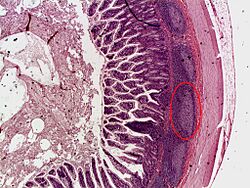Peyer's patch facts for kids
Quick facts for kids Peyer's patch |
|
|---|---|
 |
|
| Cross section of ileum with a Peyer's patch circled | |
| Latin | noduli lymphoidei aggregati |
| System | Lymphatic system |
Peyer's patches are special groups of immune cells found in your small intestine. They are a very important part of your body's defense system. These patches help protect you from germs and harmful things that enter your body through food. They are named after a scientist named Johann Conrad Peyer.
Contents
Discovering Peyer's Patches
Scientists first saw Peyer's patches in the 1600s. But it was a Swiss scientist named Johann Conrad Peyer who described them very clearly in 1677. He thought they were glands that helped with digestion.
Later, in 1850, another Swiss doctor, Rudolph Oskar Ziegler, looked at them closely under a microscope. He figured out that Peyer's patches were actually part of the lymphatic system. This system is a key part of your body's defenses.
What Peyer's Patches Look Like
Peyer's patches look like small, oval or round bumps inside your small intestine. They are usually a few centimeters long. Most people have about 100 of these patches.
You can find them mostly in the lower part of your small intestine, called the ileum and jejunum. They are like tiny versions of lymph nodes found in your gut.
The number of Peyer's patches you have is highest when you are between 15 and 25 years old. After that, the number slowly goes down.
Special Cells in Peyer's Patches
Peyer's patches have a special lining called the follicle-associated epithelium (FAE). This lining is different from the rest of your intestine. It has fewer cells that make mucus.
It also has special cells called M cells (microfold cells). These M cells are like tiny scouts. They help pick up small pieces of germs or other foreign things from inside your intestine. Then, they show these pieces to the immune cells in the Peyer's patch.
How Peyer's Patches Protect You
Your digestive system is open to the outside world. This means many tiny living things, like bacteria and viruses, can enter your body through food. Peyer's patches are like watchful guards. They help your immune system keep an eye on everything in your gut.
Fighting Germs
When harmful germs or other foreign substances enter your intestine, they meet the immune cells in Peyer's patches. These cells include:
- Macrophages and dendritic cells: These are like "clean-up" cells that can grab and show parts of germs to other immune cells.
- B-lymphocytes (B cells): These cells make special proteins called antibodies that can stick to germs and mark them for destruction.
- T-lymphocytes (T cells): These cells can directly kill infected cells or help other immune cells do their job.
Peyer's patches work a lot like your tonsils. Just as tonsils trap germs in your throat, Peyer's patches trap foreign particles in your gut. They then check them out and help destroy them.
Immune Response
When immune cells in Peyer's patches meet a germ, they get activated. These activated cells then travel to other parts of your body, like the mesenteric lymph nodes. Here, the immune response gets stronger.
Finally, these powerful immune cells travel through your bloodstream back to your gut. There, they work to fight off the infection and keep you healthy. Peyer's patches are also where B cells learn and grow stronger to fight future infections.
Peyer's Patches and Your Health
While Peyer's patches are important for your immune system, sometimes they can cause problems if they grow too large.
For example, if Peyer's patches become too big, it can sometimes lead to a condition called intussusception in children. This is a rare problem where one part of the intestine slides into another part, like a telescope. Having had a viral illness can sometimes make Peyer's patches swell up.
Certain germs, like Salmonella typhi (which causes typhoid fever) and poliovirus, can also target Peyer's patches.
Sometimes, problems with Peyer's patches and the tiny living things in your gut can be linked to autoimmune diseases. One example is Crohn's disease. In these conditions, your immune system might become too active and cause inflammation in your gut.
See also

